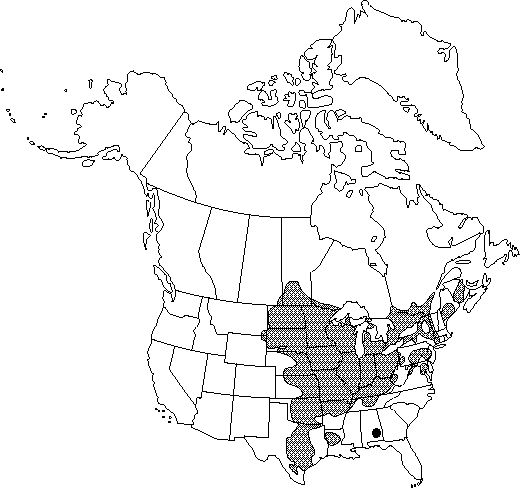Difference between revisions of "Quercus macrocarpa"
Hist. Chênes Amér., plates 2, 3. 1801.
FNA>Volume Importer |
imported>Volume Importer |
||
| (2 intermediate revisions by 2 users not shown) | |||
| Line 64: | Line 64: | ||
|publication year=1801 | |publication year=1801 | ||
|special status=Endemic;Illustrated | |special status=Endemic;Illustrated | ||
| − | |source xml=https:// | + | |source xml=https://bitbucket.org/aafc-mbb/fna-data-curation/src/2e0870ddd59836b60bcf96646a41e87ea5a5943a/coarse_grained_fna_xml/V3/V3_397.xml |
|genus=Quercus | |genus=Quercus | ||
|section=Quercus sect. Quercus | |section=Quercus sect. Quercus | ||
Latest revision as of 21:48, 5 November 2020
Trees, deciduous, to 30(-50) m. Bark dark gray, scaly or flat-ridged. Twigs grayish or reddish, 2-4 mm diam., often forming extensive flat, radiating, corky wings, finely pubescent. Buds 2-5(-6) mm, glabrous. Leaves: petiole (6-)15-25(-30) mm. Leaf blade obovate to narrowly elliptic or narrowly obovate, often fiddle-shaped, (50-)70-150(-310) × (40-)50-130(-160) mm, base rounded to cuneate, margins moderately to deeply lobed, toothed, deepest sinuses near midleaf (at least in proximal 2/3), sinuses reaching nearly to midrib, longer lobes grading into shallow lobes or merely simple teeth distally, shallower, compound lobes proximally, secondary veins arched, divergent, 4-5(-10) on each side, apex broadly rounded or ovate; surfaces abaxially light green or whitish, with minute appressed-stellate hairs forming dense, rarely sparse, tomentum, erect felty hairs absent, adaxially dark green or dull gray, sparsely puberulent to glabrate. Acorns 1-3 on stout peduncle (0-)6-20(-25) mm; cup hemispheric or turbinate, (8-)15-50 mm deep × (10-)20-60 mm wide, enclosing 1/2-7/8 nut or more, scales closely appressed, laterally connate, broadly triangular, keeled, tuberculate, finely grayish tomentose, those near margins often with soft awns to 5-10 mm or more, forming fringe around nut; nut light brown or grayish, ovoid-ellipsoid or oblong, (15-)25-50 × (10-)20-40 mm, finely puberulent or floccose. Cotyledons distinct. 2n = 24.
Phenology: Flowering in spring.
Habitat: Bottomlands, riparian slopes, poorly drained areas, prairies, usually on limestone or calcareous clays (in nw part of range on dry slopes and ridges, prairies)
Elevation: 0-1000 m
Distribution

Man., N.B., Sask., Ont., Que., Ala., Ark., Conn., Ill., Ind., Iowa, Kans., Ky., La., Maine, Md., Mass., Mich., Minn., Mo., Mont., Nebr., N.J., N.Y., N.Dak., Ohio, Okla., Pa., S.Dak., Tenn., Tex., Vt., Va., W.Va., Wis., Wyo.
Discussion
Quercus macrocarpa is one of our most cold-tolerant oak species; it also endures a wide variety of other harsh conditions including poor dry soils and wet, poorly drained, and inundated locations. Putative hybrids with Q. bicolor are common in the northeastern part of its range, where the two species often occur together in wet, poorly drained habitats. The effect of this contact may be partially responsible for morphologic differences across the range of Q. macrocarpa. The large acorns are best developed in the southern part of the range, and a clinal decrease in acorn size and extent of the mossy fringe on the acorn cup seems to occur as one travels from south to north. In the northwest part of its range, Q. macrocarpa varies clinally to smaller, shrubbier forms on bluffs and hillsides, with smaller, less fringed cups, that are the basis of Q. macrocarpa var. depressa (Nuttall) Engelmann and Q. mandanensis Rydberg. These scrubby forms may merit formal recognition after more thorough study; they are treated here as clinal variants of the species. Quercus macrocarpa forms putative hybrids also with Q. alba in the savannah-type regions of the midwest. Putative hybrids with Q. gambelii occur out of the range of Q. macrocarpa.
Quercus macrocarpa is the only oak species native to Montana (in the southeast corner). Wood of Q. macrocarpa is similar to that of Q. alba and produces one of the best and most durable oak lumbers.
Native Americans used Quercus macrocarpa medicinally to treat heart troubles, cramps, diarrhea, Italian itch, and broken bones, to expel pinworms, and as an astringent (D. E. Moerman 1986).
Selected References
None.
